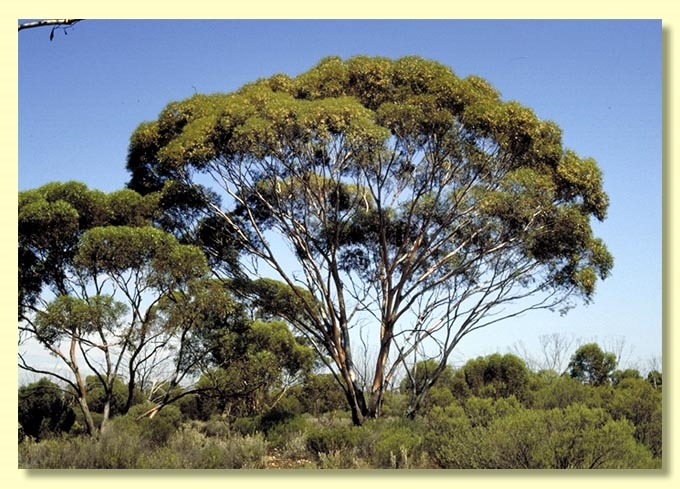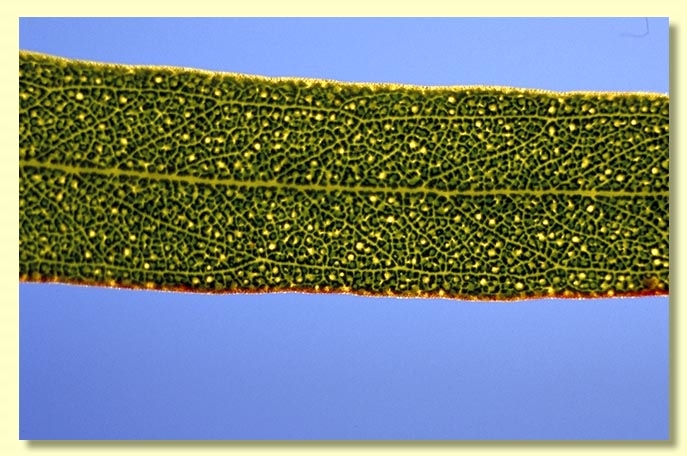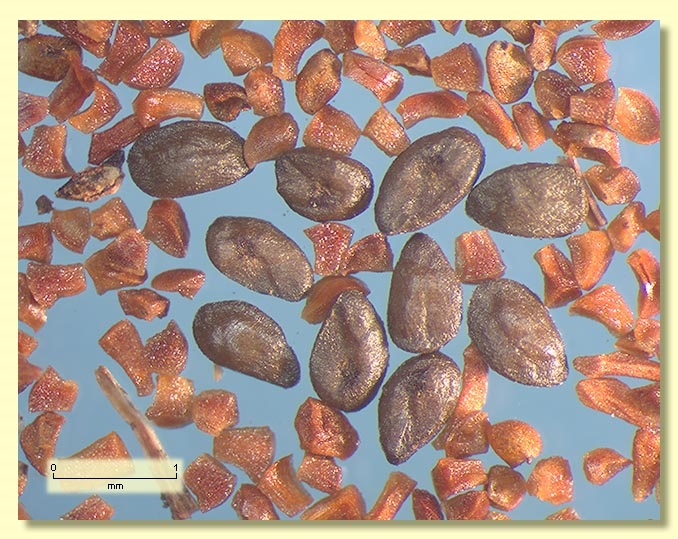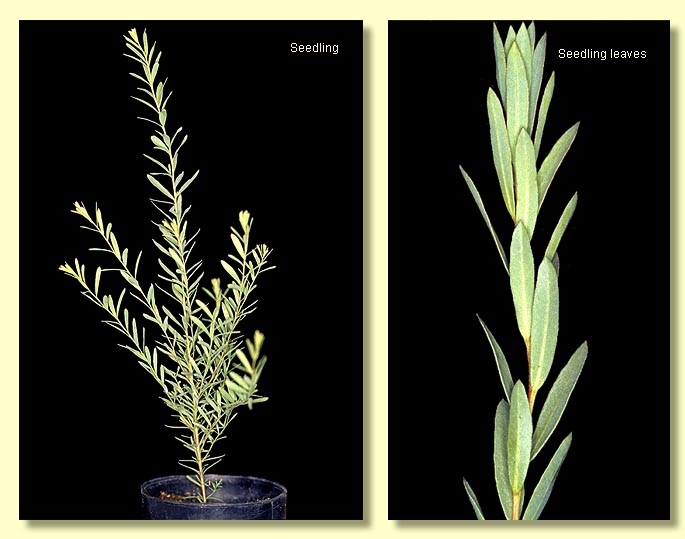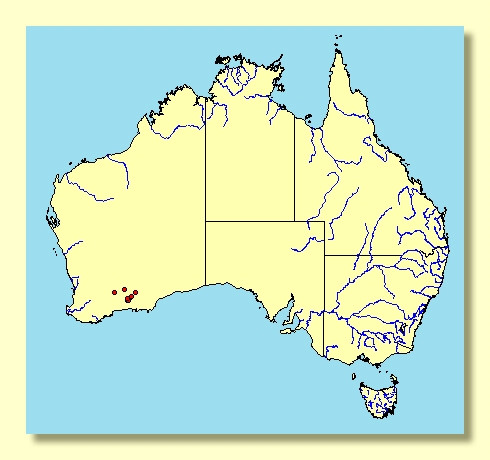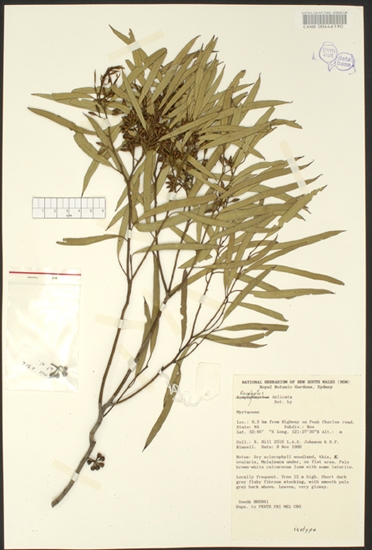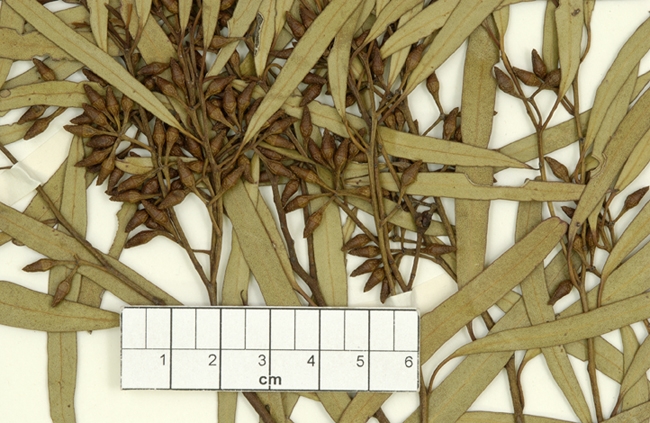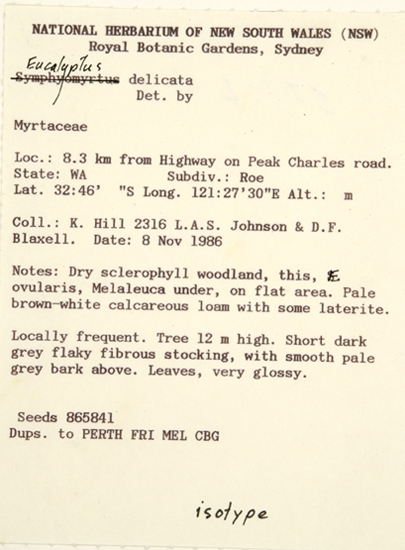Eucalyptus | Symphyomyrtus | Bisectae | Destitutae | Subulatae | Spirales
Euclid - Online edition
Eucalyptus delicata
Bark rough over most or on the lower portion of stem, dark grey to grey-brown, fibrous to scaly, smooth bark above white to pink-grey.
Branchlets lacking oil glands in the pith.
Juvenile stem many-sided, juvenile leaves spirally arranged for many nodes ("heath-like") but by 50 cm tall becoming alternately arranged, sessile to shortly petiolate, linear to narrowly elliptic-oblong to narrowly lanceolate, 0.8-7.5 cm long, 0.2-1.7 cm wide, base tapering, margin entire, apex rounded to pointed, dull, grey-green.
Adult leaves alternate, petioles (0.5)0.8–1.7 cm long; blade linear to narrowly lanceolate, (6)7–10(11) cm long, 0.5–1 cm wide, base tapering to petiole, margin entire, apex pointed, green, glossy, side-veins at an acute or wider angle to midrib, reticulation dense, intramarginal vein close to margin, oil glands large, round, numerous, intersectional.
Inflorescence axillary unbranched, peduncles 0.7–1.5 cm long, buds 7, 9 or 11 per umbel, pedicels 0.2–0.5 cm long. Mature buds ovoid (0.5–0.8 cm long, 0.3 cm wide), scar present, operculum conical to rounded (0.2–0.5 cm long), stamens irregularly flexed, anthers more or less globular, basifixed and almost adnate, dehiscing by short lateral slits, style long and straight, stigma blunt, locules 3, the placentae each with 4 vertical rows of ovules. Flowers creamy white.
Fruit pedicellate (pedicels 0.2–0.4 cm long), truncate-globose to barrel-shaped, 0.4–0.5 cm long, 0.4–0.5 cm wide, disc descending, valves appearing prominently exserted due to persistent fragile style remnants.
Seeds brown-grey, 1–2 mm long, ovoid to flattened or depressed-ovoid, dorsal surface smooth, hilum ventral.
Cultivated seedlings (measured at ca 25 cm tall): cotyledons Y-shaped (bisected), stems many-sided, leaves opposite for ca 3 nodes then becoming spirally arranged for many nodes ("heath-like"), sessile to subsessile, linear to very narrowly elliptic-oblong, 0.5–2.7 cm long, 0.2–0.7 cm wide, base tapering, margin entire, apex rounded to pointed, dull, grey-green to green. Lignotuber not visible as a swelling on seedling stem.
Flowering has been recorded in March.
Normally a small to medium-sized tree growing from east of the cross-roads east of Hyden, south-east to Peak Charles and Kumarl, extending north-east to the Norseman – Fraser Range area.
Eucalyptus delicata belongs in Eucalyptus subgenus Symphyomyrtus section Bisectae subsection Destitutae because buds have two opercula, cotyledons are Y-shaped and branchlets lack oil glands in the pith. Within this subsection E. delicata is part of a large taxonomic series Subulatae further characterised by globoid basifixed anthers, grey smooth seeds with shallow longitudinal furrows, and fruit with persistent exserted style remnants. Series Subulatae is divided principally into four subseries based on the juvenile leaves: one with spiral, crowded seedling phyllotaxis (subseries Spirales), another with decussate and decurrent seedling leaves (subseries Decurrentes), another with decussate non-decurrent seedling leaves (subseries Decussatae), and a fourth with disjunct, petiolate seedling leaves (subseries Oleaginae).
Eucalyptus delicata is in subseries Spirales together with E. longicornis and E. oleosa and can be distinguished from these two species by its small narrow adult leaves and the small buds and fruit. Because of its fruit size, E. delicata apparently has been confused with Salmon Gum (E. salmonophloia) and can be easily separated from that by the presence of rough bark on the trunk (colourful smooth bark in E. salmonophloia) and irregularly flexed staminal filaments (regularly inflexed in E. salmonophloia).
E. longissima is another closely related species of series Subulatae with relatively small buds and fruit. E. longissima (subseries Oleaginae) can be easily recognised by having lanceolate, petiolate juvenile leaves (linear and sessile to sub-sessile in E. delicata) and is normally a mallee in habit.

